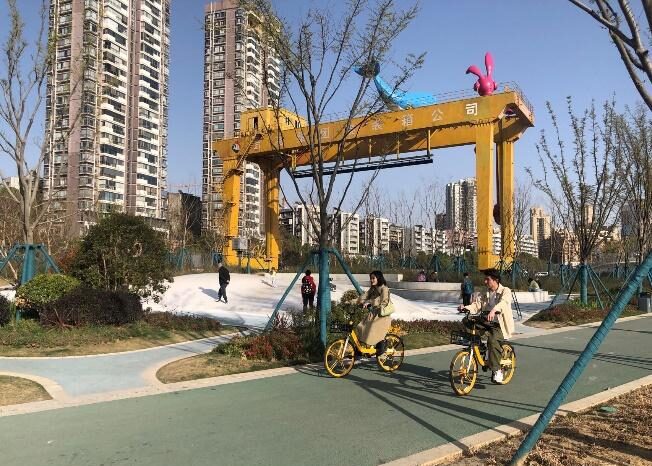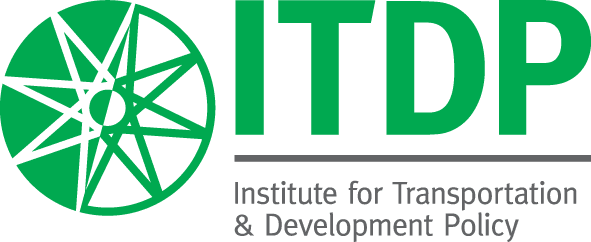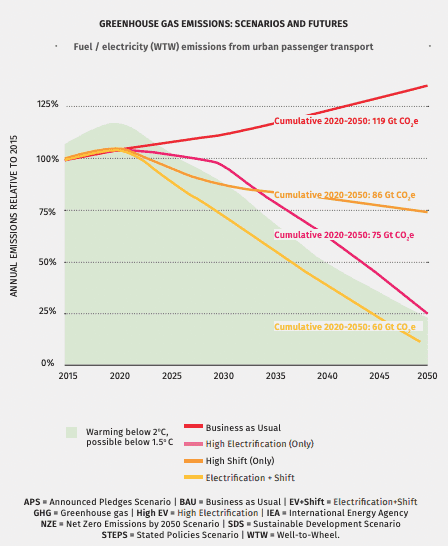Home > Our Impact > Urban Mobility

Urban Mobility
Transportation contributes the largest, and a still growing, share of energy-related carbon emissions worldwide. Urban mobility is a major contributor, as the use of high-emitting motor vehicles is escalating globally. ITDP works in key cities around the world to promote zero-emission, sustainable, and inclusive urban mobility. ITDP uses four interlocking strategies to accomplish the greatest possible impact: advancing inclusive, compact cities; increasing accessible, low- to no-emission mobility; promoting transport electrification; and controlling polluting, private vehicles. These four strategies are each powerful, but combining them achieves an impact greater than the sum of its parts.
Policies to increase transit, cycling, and walking
High-quality transit, cycling, and walking facilities in cities can coax people out of their cars and shift trips to cleaner modes, delivering significant GHG reductions. Walking and cycling are cost-effective, zero-emission modes of transport. Public transport, whether metros or buses, carries multitudes more passengers than light-duty vehicles, resulting in a fraction of the GHG emissions per trip—or even zero emissions per trip on clean buses and trains. Key policies to promote sustainable transport include providing cities financial resources to construct and operate high-quality systems, ensuring comprehensive data availability to inform planning, and implementing complementary compact urban development policies.
Policy spotlight
In 2015, with support from ITDP China, the city of Guangzhou proposed to vigorously pursue a public bicycle system. According to the Guangzhou Municipal Transportation Bureau, 99.3 km of cycling network has been retrofitted and 87.3 km of bicycle lanes protected by a barrier have been newly constructed. A 2022 study by ITDP determined that these protected cycle lanes helped the city avoid an estimated 16,000 tonnes CO2e of GHG emissions per year, which is equivalent to the amount of carbon that would be sequestered by planting 300,000 new trees every year.
Zero-emission fleet transition road maps and zero-emission areas
Transport electrification and other clean technologies are critical to address air pollution and reduce climate emissions. On a per-trip basis, e-buses maximize the value of government support most effectively. Transitioning to e-buses requires the adoption of road maps that lay out a pathway to introduce clean bus fleets. Success with e-buses holds potential for positive spillover effects to other vehicles, such as heavy-duty freight. Electric two- and three-wheelers are another important part of the solution, particularly for shorter trips. Further, cities can deploy zero-emission areas to restrict polluting vehicles’ access to key locations, thus incentivizing a shift to clean modes. Implementing zero-emission areas in more cities will promote demand for clean vehicles, including e-buses.
Policy spotlight
In 2023, ITDP Africa supported the launch of a landmark all-electric bus rapid transit corridor in Dakar, Senegal, that could help avoid around 350,000 tonnes of cumulative GHG emissions through 2030. This system is a great example of how cities can reduce urban transport emissions through the shift-avoid-improve model, which ITDP’s compact cities modeling has shown to offer the greatest benefits in reducing GHG emissions and keeping warming below the 1.5 degree threshold.
Compact urban development policies, including parking management
Compact, pedestrian- and transit-oriented development, in which residential and mixed-use buildings are planned around public transport, is critical to move away from sprawl and car dependency. Compact urban development limits motorized vehicle trips, which directly cuts emissions. Meanwhile, free or inexpensive parking can undermine gains in other areas by triggering unnecessary driving and stoking congestion. Parking management policies that limit the availability of parking spaces can encourage a shift to more sustainable modes of transport, like transit. Key policies include guiding the location and design of new buildings and open spaces, ensuring appropriate zoning laws, removing minimum parking requirements for new buildings, and reforming on-street parking.
Policy spotlight
The team at ITDP Mexico has been instrumental in the passage of a parking mandate in Mexico City, advocating for the policy for nearly a decade prior to its successful implementation in 2017. This policy is estimated to avoid 584,000-638,000 metric tons of CO2e annually from off-street parking construction, equivalent to the amount of carbon sequestered by planting 9-10 million trees every year.
Improved development finance and national funding investments
Despite recent growth in low-carbon infrastructure investment, a huge gap remains for sustainable transport, with most transport finance flowing to high-carbon systems. Overcoming this gap will require shifting investment policies and practices at multilateral and national development banks, improving municipal capacity to attract finance, increasing green bonds for sustainable transport, and overcoming barriers for private finance. Multilateral development banks and bilateral aid agencies are particularly important players, as they provide billions of dollars in finance for transport projects every year. The banks must act to shift financial flows away from dirty investments and toward low-emission investments. By unlocking finance from development banks for climate-friendly transport, countries can implement more projects while leveraging development bank finance to attract other finance.
Policy spotlight
In Yichang, China, a major ITDP project backed by the World Bank is reshaping local emissions standards and aiming to retire over 14,000 high-emission vehicles—including numerous public buses—as part of a regional vision for urban mobility.

Ensuring equity
If we design our cities for the most vulnerable people, they will work better for everyone. Transport systems designed for the solo, male, able-bodied commuter can be hostile environments for everyone else. Transit is cumbersome or physically impossible for those with limited mobility, when carrying groceries or daily goods, or traveling with children or elderly relatives. Women, who typically perform primary caretaker roles in addition to performing paid work, tend to make more frequent and shorter trips with multiple purposes, which many transit systems make difficult. Sexual harassment in public spaces and transit is a common problem everywhere in the world, effectively constraining the rights and movements of women and LGBTQIA+ people. By improving public transport options in cities and prioritizing safety in public spaces, the transport sector can play a major role in advancing equity on a global scale.




